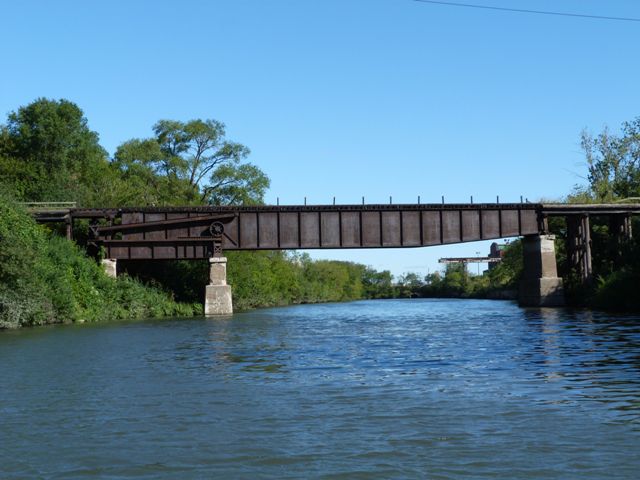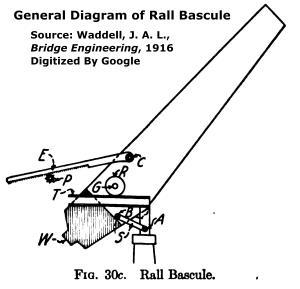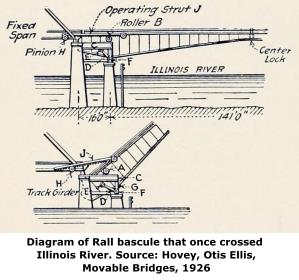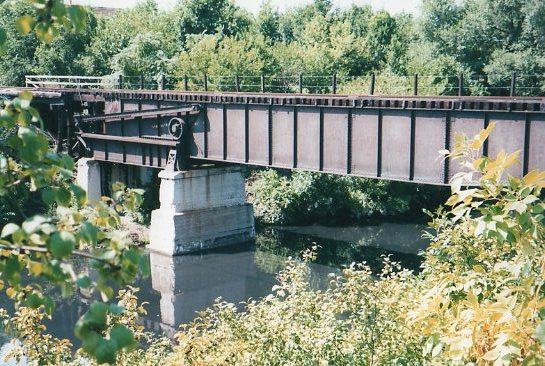We Recommend:
Bach Steel - Experts at historic truss bridge restoration.
BridgeHunter.com Phase 1 is released to the public! - Visit Now
Chicago and Illinois Western Railway Bridge

Primary Photographer(s): Nathan Holth
Bridge Documented: September 7, 2011
Railroad (Chicago and Western Indiana) Over Collateral Channel (Canal Slip)
Chicago: Cook County, Illinois: United States
1914 By Builder/Contractor: Strobel Steel Construction Company of Chicago, Illinois and Engineer/Design: Theodor Rall
Not Available or Not Applicable
Not Available
Not Available
Not Available
1 Main Span(s)
Not Applicable

View Information About HSR Ratings
Bridge Documentation
View The Rall Bascule Bridge Patent
View Excerpts From Two Historical Texts Describing Rall Bascule Bridges
This bridge is one of the most unusual and rare movable bridges in Chicago, and has been recognized and protected by its designation as a Chicago Landmark. It is one of the few examples nationwide of a Rall bascule bridge. The patented design involves a bascule leaf that rests on roller bearings that roll back on a short track as the leaf raises. This is different from a Scherzer rolling lift bridge because in a rolling lift bridge the leaf bears directly on a track and there is no roller bearing. The original patent for the bridge design has a drawing shown above that shows the motion of a Rall bascule bridge. The Chicago and Illinois Western Railway has the essential details outlined in the patent. According to the comments in the Chicago Landmarks list, the bridge was built in 1914.
Theodor Rall, the inventor of the Rall bascule bridge, was the chief engineer of the Strobel Steel Construction Company. A 1917 advertisement for Strobel Steel Construction Company, makes a point of stating that the company designed and built Rall bascule bridges. The company also built trunnion bascule bridges, and indeed was a contractor for a number of trunnion bascule bascule bridges in Chicago as well.

According to a 1923 edition of the Engineering News-Record, Theodor Rall, whose name was misspelled as "Theodore" was reported to have died.
Some websites and other resources make vague claims that Chicago has a "retractile" movable bridge. HistoricBridges.org believes these claims to be false, and that Chicago does not have a retractile bridge. It may in fact be that these resources are referring to this Rall bascule bridge. The confusion may come from the fact that this bridge does roll back on a short track as the bascule lifts. This bridge is not a retractile bridge however. Retractile bridges do not rotate up like this bridge does, they simply slide back.
The Collateral Channel was constructed in the 1890s to connect the West Fork of the South Branch of the Chicago River to the Chicago Sanitary and Ship Canal. Some time after the channel was built, the West Fork was completely filled in, and today there is no remaining visible trace of the West Fork. The Collateral Channel remained however as a slip for the Chicago Sanitary and Ship Canal.
This bridge has industrial properties surrounding it, making it impossible to get beside or under the bridge from on land, therefore requiring a boat to get a full photo-documentation of the bridge. Thanks to Tom Winkle for providing boat transportation to assist in the photo-documentation of this historic bridge.
Information and Findings From Chicago Landmarks DesignationGeneral Information Address: 33rd St., East of Kedzie Ave. (Slip of
Sanitary and Ship Canal) This Bridge Is A Designated Chicago Landmark |
![]()
Historic Bridges of Chicago and Cook County


Chicago and Cook County are home to one of the largest collections of historic bridges in the country, and no other city in the world has more movable bridges. HistoricBridges.org is proud to offer the most extensive coverage of historic Chicago bridges on the Internet.
General Chicago / Cook County Bridge Resources
Chicago's Bridges - By Nathan Holth, author of HistoricBridges.org, this book provides a discussion of the history of Chicago's movable bridges, and includes a virtual tour discussing all movable bridges remaining in Chicago today. Despite this broad coverage, the book is presented in a compact format that is easy to take with you and carry around for reference on a visit to Chicago. The book includes dozens of full color photos. Only $9.95 U.S! ($11.95 Canadian). Order on Amazon.
Chicago River Bridges - By Patrick T. McBriarty, this is a great companion to Holth's book shown above. This much larger book offers an extremely in-depth exploration of Chicago's movable highway bridges, including many crossings that have not existed for many years. Order Now Direct From The Publisher! or order on Amazon.
View Historic American Engineering Record (HAER) Overview of Chicago Bascule Bridges (HAER Data Pages, PDF)
Chicago Loop Bridges - Chicago Loop Bridges is another website on the Internet that is a great companion to the HistoricBridges.org coverage of the 18 movable bridges within the Chicago Loop. This website includes additional information such as connections to popular culture, overview discussions and essays about Chicago's movable bridges, additional videos, and current news and events relating to the bridges.
Additional Online Articles and Resources - This page is a large gathering of interesting articles and resources that HistoricBridges.org has uncovered during research, but which were not specific to a particular bridge listing.
![]()
Photo Galleries and Videos: Chicago and Illinois Western Railway Bridge
Bridge Photo-Documentation
Original / Full Size PhotosA collection of overview and detail photos. This gallery offers photos in the highest available resolution and file size in a touch-friendly popup viewer.
Alternatively, Browse Without Using Viewer
![]()
Bridge Photo-Documentation
Mobile Optimized PhotosA collection of overview and detail photos. This gallery features data-friendly, fast-loading photos in a touch-friendly popup viewer.
Alternatively, Browse Without Using Viewer
![]()
1987 Photos
Mobile Optimized PhotosA collection of overview and detail photos taken by Don Sadecki. Scans of photos taken in 1987. This gallery features data-friendly, fast-loading photos in a touch-friendly popup viewer.
Alternatively, Browse Without Using Viewer
![]()
Maps and Links: Chicago and Illinois Western Railway Bridge
Coordinates (Latitude, Longitude):
Search For Additional Bridge Listings:
Bridgehunter.com: View listed bridges within 0.5 miles (0.8 kilometers) of this bridge.
Bridgehunter.com: View listed bridges within 10 miles (16 kilometers) of this bridge.
Additional Maps:
Google Streetview (If Available)
GeoHack (Additional Links and Coordinates)
Apple Maps (Via DuckDuckGo Search)
Apple Maps (Apple devices only)
Android: Open Location In Your Map or GPS App
Flickr Gallery (Find Nearby Photos)
Wikimedia Commons (Find Nearby Photos)
Directions Via Sygic For Android
Directions Via Sygic For iOS and Android Dolphin Browser
USGS National Map (United States Only)
Historical USGS Topo Maps (United States Only)
Historic Aerials (United States Only)
CalTopo Maps (United States Only)







